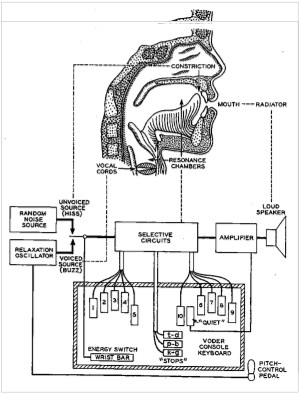Bernard Dionysus Geoghegan: The Cybernetic Apparatus: Media, Liberalism, and the Reform of the Human Sciences (2012)
Filed under thesis | Tags: · cybernetics, history of technology, liberalism, linguistics, structuralism, technology

“The Cybernetic Apparatus examines efforts to reform the human sciences through new forms of technical media. It demonstrates how 19th-century political ideals shaped mid-20th-century programs for cybernetic research and global science sponsored by the Rockefeller Foundation. Through archival research and textual analysis, it reconstructs how and why new media, especially digital technologies, were understood as part of a neutral and impartial apparatus for transcending disciplinary, ethnic, regional, and economic differences. The result is a new account of the role of new media technologies in facilitating international and interdisciplinary collaboration (and critique) in the latter half of the twentieth century.
Chapter one examines how political conceptions of communications and technology in the United States in the nineteenth century conditioned the understanding and deployment of media in the twentieth century, arguing that American liberals conceived of technical media as part of a neutral apparatus for overcoming ethnic, geographic, and economic difference in the rapidly expanding nation. Chapter two examines the development of new media instruments as technologies for reforming the natural and human sciences from the 1910s through the 1940s, with particular attention to programs administered by the Rockefeller Foundation. Chapters three and four examine the rise, in the 1940s and 1950s, of cybernetics and information theory as an ideal of scientific neutrality and political orderliness. These chapters demonstrate how programs sponsored by the Rockefeller Foundation, MIT, and other institutions shaped linguist Roman Jakobson’s and anthropologist Claude Lévi-Strauss’s efforts to redefine their fields as communication sciences. Chapter five considers how critics of cybernetics, including Noam Chomsky, Claude Shannon, and Roland Barthes, critically re-evaluated the claims of cybernetics to redefine the relations between technical research and the human sciences.”
PhD dissertation
Northwestern University & Bauhaus-Universität Weimar, 2012
262 pages
Author
Related paper by the author: From Information Theory to French Theory: Jakobson, Lévi-Strauss, and the Cybernetic Apparatus (Critical Inquiry 38, Autumn 2011)
PDF (6 MB, updated on 2021-3-9)
EPUB (2 MB, added on 2021-3-9)
K. G. Beauchamp: Exhibiting Electricity (1997)
Filed under book | Tags: · 1800s, 1900s, electricity, engineering, exhibition, history of science, history of technology, machine, science, technology, telegraphy

“This unusual book traces the history of public and technical exhibitions, from their origins in the late 18th century to present day, and, particularly, how they have reflected the progress of science and technology (especially electrical technology). Not only does the author show how electrical innovation and manufacture have been presented to the wider public through this period, but he also shows how the exhibitions themselves have required technological advice. It is through this combination of roles that the importance of these exhibitions within scientific and technological advance can be understood.”
Publisher Institution of Electrical Engineers, 1997
IEEE History of Technology Series, Volume 21
ISBN 0852968957, 9780852968956
352 pages
review (Bernard S. Finn, Technology and Culture)
review (Iwan Rhys Morus, The British Journal for the History of Science)
Catherine Pagani: “Eastern Magnificence & European Ingenuity”: Clocks of Late Imperial China (2001)
Filed under book | Tags: · 1500s, 1600s, 1700s, automata, china, clock, history of technology, time

“The period from the late sixteenth to the late eighteenth centuries was one of complex change for the Chinese. Europe was eagerly looking to the East with an interest in developing a China market, not just in commercial and diplomatic enterprises but in evangelical ventures as well. The resulting contacts produced significant cultural exchanges and appropriations, as well as misconceptions and stereotypes. Profoundly affected by these interactions were the areas of technology and the decorative arts. Europe became enamored of Chinese style, and a fashion known as chinoiserie permeated the decorative arts. In China, one result of Sino-European contact was the introduction of a new and important technology: the Western mechanical clock.
Called in Chinese zimingzhong, or “self-ringing bells,” these elaborate clocks were used as status symbols, decorative items, and personal adornments, and only occasionally as timepieces. Most importantly, they were signifiers of cultural power: Europeans, whether missionaries or ambassadors, controlled the introduction of both object and technology, and they used this control to advantage in gaining access to the highest reaches of Chinese society.
Through her focus on technology and the decorative arts, Catherine Pagani contributes to an overall understanding of the nature and extent of European influence in late Imperial China and of the complex interaction between these two cultures. This study’s interdisciplinary approach will make it of interest to those in the fields of art history, the history of clockwork and of science and technology, Jesuit history, Qing-dynasty history, and Asian studies, as well as to the educated general reader.”
Publisher University of Michigan Press, Ann Arbor, 2001
ISBN 0472112082, 9780472112081
286 pages
See also Volume 4-2 (part j) of Joseph Needham’s Science and Civilisation in China
Comment (0)
